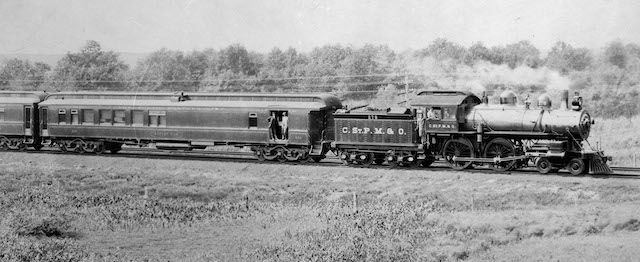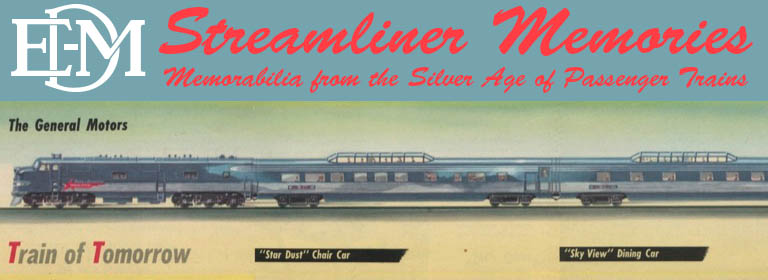The Chicago-Twin Cities corridor was served by a remarkable number of railroads. In addition to the St. Paul, North Western, and Burlington, the Wisconsin Central (later Soo Line), Minneapolis & St. Louis, Chicago Great Western, and Rock Island all attempted to compete in this corridor. In the earliest years, however, it was just the St. Paul and Chicago & North Western.

This Detroit Publishing photo of a “North Western Line” train pulled by an Omaha road locomotive is probably the North-Western Limited as that was the only train with a buffet car on the Chicago-Minneapolis line. Built by Schenectady in 1898, the F-8 class locomotive has 73″ drivers and produced nearly 19,200 pounds of tractive effort. Click image for a larger view..
Although the St. Paul road was the first to connect St. Paul with Milwaukee and Chicago, it didn’t have a monopoly for long. While the Milwaukee & St. Paul was building to St. Paul, the Chicago & North Western was building across southern Wisconsin and Minnesota with an eye towards the gold fields of South Dakota. Meanwhile, another company called the West Wisconsin Railway built a line from St. Paul to Elroy, Wisconsin, where it connected with the C&NW. The West Wisconsin route arrived in St. Paul only a few months after the Milwaukee & St. Paul.
Initially, C&NW had no financial interest in the West Wisconsin, but eventually the West Wisconsin became part of the Chicago, St. Paul, Minneapolis and Omaha (known as the Omaha road), which by 1880 was under the C&NW’s control. Long before that, however, the C&NW and West Wisconsin offered through passenger service from Chicago to St. Paul.
In 1874, trains over this route took 21 hours and 40 minutes from Chicago to St. Paul and 21 hours and 55 minutes from St. Paul to Chicago — about the same as Milwaukee & St. Paul trains. The C&NW advertised that these trains had “Pullman Palace Drawing-Room and Sleeping Cars,” meaning cars with around a dozen sections and one drawing room.
Initially, C&NW didn’t try to offer service to Minneapolis but eventually built a bridge across the Mississippi River and later used Great Northern’s Stone Arch Bridge. If Chicago & North Western was second to arrive in both St. Paul and Minneapolis, it was also second to the Chicago, Milwaukee & St. Paul in just about everything else: second to have electric lighting, second to provide all-steel cars, second to be streamlined.

The description on this postcard claims the train is the North Western Limited. However, the same photo was also used on postcards supposedly showing the Overland Limited. Either way, it suggests that in the early years of the train it consisted of five cars. It is worth noting that the cars are painted green while on the Overland version of the postcard the cars were painted red. The lower righthand corner of the card has the word “Oilette,” a trademark of Tuck’s postcard company for its method of colorizing black-and-white photos, which it claimed produced “veritable miniature oil paintings.” Though the card is postmarked 1911, it is likely that the original photograph was taken years earlier as by 1911 the 4-4-2 locomotive in the picture would have been replaced by a 4-6-2 and there would have been more cars on the train. Click image to download a 238-KB PDF of this postcard.
It was, however, the first to have a named limited train in the Chicago-Twin Cities corridor. By early 1892, both it and the St. Paul road had reduced Chicago-Minneapolis travel times to about 14 hours. The North Western scheduled its overnight train to leave Chicago at 6 pm and arrive in Minneapolis at 8:03 am; the return train left at 7:25 pm and arrived in Chicago at 9:30 am, both just a few minutes over 14 hours.
Through most of 1892, the North Western’s Official Guide listings called this train a “Vestibuled Limited,” which was a description, not a name. The train included “new Buffet Smoking and Library Cars, Private Compartment Sleeping Cars and Drawing Room Sleeping Cars.” The railroad concluded by saying that the “Entire train [is] lighted by gas.”
In the October 1892 Official Guide, however, the same train is listed with the same description and times but now with a name: the North-Western Limited.” The railroad was inconsistent about whether “North-Western” should be hyphenated, but the “W” was almost always capitalized.

In 1898, the C&NW advertised the North-Western Limited as a “20th century train” because it featured electric lighting — something that had been added to competitor St. Paul road trains ten years before. From the collection of Ralph Justen.
The St. Paul road had installed electric lighting on its Chicago-Minneapolis train in September 1888. The C&NW didn’t use electric lighting until its competitor introduced the luxurious new Pioneer Limited in 1898. Then, it advertised that it had a “20th century train” due to its electric lights and steam heat.

This unusual die-cut ad, which appears to be a blotter, mentions “steel” trains so is probably from 1915 or later. From the collection of Ralph Justen.
C&NW replaced its train with all-steel cars by 1916. The above ad mentions “steel,” which could mean all-steel or just steel frames and sheathing. Unfortunately, none of the timetables available to me match the times shown on the ad, but based on the timetables I do have, it is from somewhere after 1914 and before 1921.
 Click image to download a 63.6-MB PDF of this 56-page timetable from the collection of Ralph Justen.
Click image to download a 63.6-MB PDF of this 56-page timetable from the collection of Ralph Justen.
In general, speeds on the North-Western Limited roughly matched those on the Pioneer Limited and their predecessors. This means they increased significantly between 1872 and 1902, then grew only slowly through at least 1926, when the train took 12-1/2 hours between Chicago and Minneapolis (33.5 mph).
The above 1932 timetable shows times of 11-1/2 hours northbound and just over 10-1/2 hours southbound. The streamlined 400s, which were introduced in 1935, zipped between Chicago and Minneapolis in just 7 hours (58 mph). The North Western Limited was slower, taking 9 hours and 50 minutes (41 mph) northbound and 10-1/4 hours (40 mph) southbound.
